The AMD Ryzen 5 1600X vs Core i5 Review: Twelve Threads vs Four at $250
by Ian Cutress on April 11, 2017 9:00 AM ESTBenchmarking Performance: CPU Web Tests
One of the issues when running web-based tests is the nature of modern browsers to automatically install updates. This means any sustained period of benchmarking will invariably fall foul of the 'it's updated beyond the state of comparison' rule, especially when browsers will update if you give them half a second to think about it. Despite this, we were able to find a series of commands to create an un-updatable version of Chrome 56 for our 2017 test suite. While this means we might not be on the bleeding edge of the latest browser, it makes the scores between CPUs comparable.
SunSpider 1.0.2 [link]
The oldest web-based benchmark in this portion of our test is SunSpider. This is a very basic javascript algorithm tool, and ends up being more a measure of IPC and latency than anything else, with most high performance CPUs scoring around about the same. The basic test is looped 10 times and the average taken. We run the basic test 4 times.
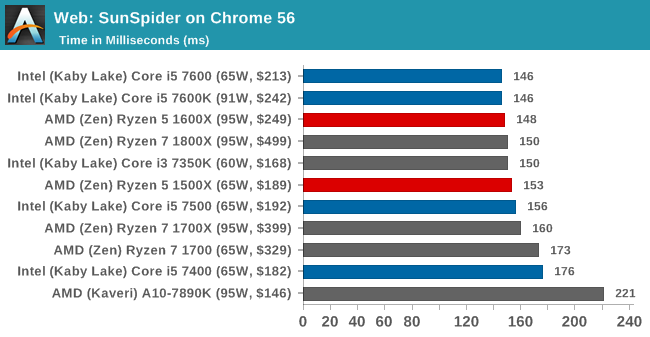
Mozilla Kraken 1.1 [link]
Kraken is another Javascript based benchmark, using the same test harness as SunSpider, but focusing on more stringent real-world use cases and libraries, such as audio processing and image filters. Again, the basic test is looped ten times, and we run the basic test four times.
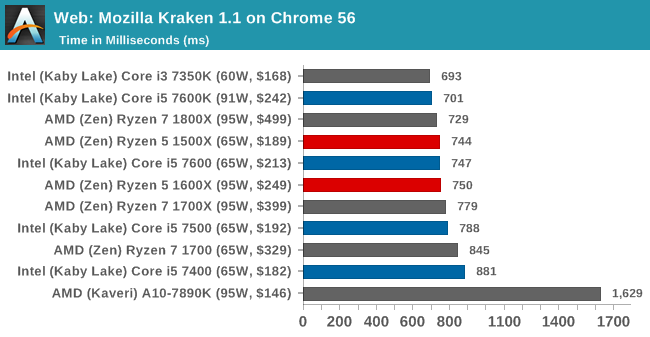
Google Octane 2.0 [link]
Along with Mozilla, as Google is a major browser developer, having peak JS performance is typically a critical asset when comparing against the other OS developers. In the same way that SunSpider is a very early JS benchmark, and Kraken is a bit newer, Octane aims to be more relevant to real workloads, especially in power constrained devices such as smartphones and tablets.
WebXPRT 2013 and 2015 [link]
While the previous three benchmarks do calculations in the background and represent a score, WebXPRT is designed to be a better interpretation of visual workloads that a professional user might have, such as browser based applications, graphing, image editing, sort/analysis, scientific analysis and financial tools. Web2013 is the older tool, superceded by Web2015, however both still are highly relevant for high-performance web applications today.
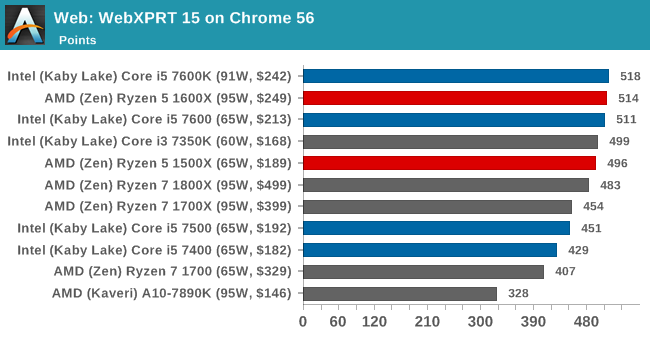


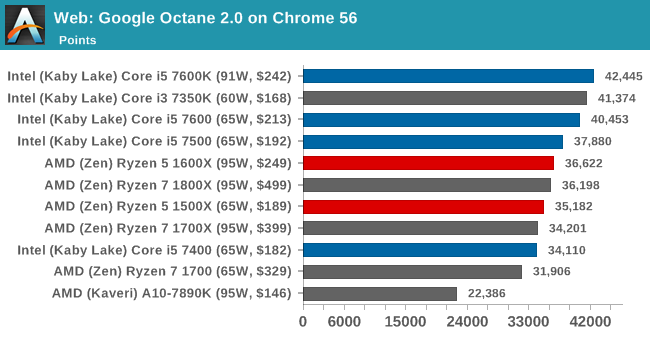
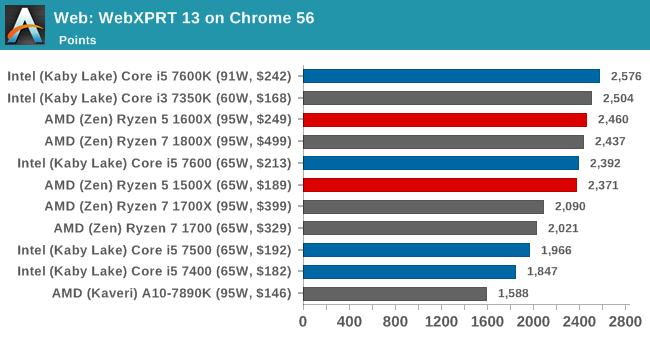








254 Comments
View All Comments
vladx - Thursday, April 13, 2017 - link
Yes as someone with both a 7700k system and a 1700X system I can safely call myself unbiased as I hold no special loyalty towards any brand.Cooe - Monday, March 1, 2021 - link
Liar liar, pants on fire lol.cryosx - Thursday, April 13, 2017 - link
they were testing against the direct competition (i5s) and the rest of the ryzen family. Makes sense, though I guess having the i7s in would be a nice touch.Nightsd01 - Wednesday, April 12, 2017 - link
"[Ryzen] has 50% more cores and 200% more threads"Wouldn't it be 300% more threads? 12 threads is 3x more than 4
Outlander_04 - Thursday, April 13, 2017 - link
200% MOREcvearl - Thursday, April 13, 2017 - link
Curious what method on GTAV was used. I get in the 70's at those settings on my RX480 all VH settings on an i7 2600k.ianmills - Thursday, April 13, 2017 - link
Dolphin benchmarks still missing!Notmyusualid - Tuesday, April 18, 2017 - link
@ianmillsI was looking for them too.
msroadkill612 - Thursday, April 13, 2017 - link
Ryzens tough for cheapskates. its a nice cheap 4 core, but gee, for so little more u get a 6 core 1600.msroadkill612 - Thursday, April 13, 2017 - link
zen is just amds first act.The second is naples - gluing multiple ryzens together using their excellent new plumbing.
The third is vega (gpu has long been amdS focus - in a10apuS e.g.).
The last and seismic act, is a ccx with a single zen core block of four cores & same 4mb l3 cache, and a vega gpu, possibly with hbm2 vram.
Its not very new ground for them. its very similar to the architecture solutions needed for the a10.
Incidentally, i heard a great debate about "dark coding?".
coders love using the gpu for compute when they can, cos it shifts heat away from stressed processors. cooler processors can then run faster. IE, they try and shift the load around the circuitry to avoid generating hot spots.
The conclusion omitted to say "if u consider pc software static.... Then buy intel"
new generation and paradigm, or the last tart up of the old generation. Your choice.
There are of course wins and losses by both, but we know that we are measuring the best of the old, with the lowest point of the rapidly improving new. (see ashes of singularitytweak)
& as above, its just act 1 now.
The authors haughty dismissal of amdS top am4 chipset features is outrageously deceptive (as said in posts here).